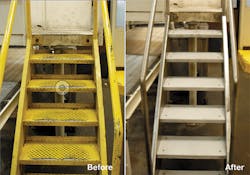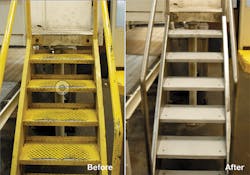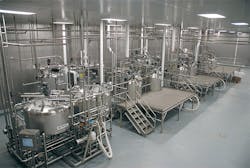Approximately 10% of walking surfaces in manufacturing and industrial workplaces, including platforms, catwalks, mezzanines, stairs, and ladders, are considered high-risk for slips and falls. These risks are compounded when water, oil, or grease enter the environment, as they often do in “wet” manufacturing plants that process chemicals, foods and beverages, and other products.
This article is part of our monthly Tactics and Practices column. Read more Tactics and Practices.
Flooring safety audits assess walking surfaces throughout the workplace to prevent slips, trips, and falls. The resulting solutions from a safety audit can prevent more than 90% of these accidents.
Surface safety assessments – Why do them?
Auditing walking surfaces is an important part of safety improvement, employee retention, and ensuring peak performance.
During challenging labor markets, no one wants to lose an employee to injury. The U.S. Bureau of Labor Statistics (BLS) reported 211,640 injury cases involving falls, slips, and trips in 2020. Many more go unreported. Sadly, 805 of them ended in fatality, according to 2020 Census data on fatal occupation injuries from the U.S. Bureau of Labor Statistics. The BLS also reports 22% of reported slip and fall incidents cause three days or more away from work.
Unsafe walking surfaces can also be a drag on productivity. Consider the difference between walking on a dry sidewalk and an icy one. People become tentative, slow their strides, and alter their gaits. The same dynamics apply to a slippery floor. When employees have to walk slowly and cautiously to avoid slipping, that slows productivity and weakens morale.
Surface safety audits: How to do them
Traffic, environment, and walking surface are the three most important surface safety factors an auditor or safety team should consider, and each has several components. It’s also important to listen to employees and revisit any injury events to determine causes.
To conduct a surface safety assessment, get out on the floor. Walk the production or manufacturing line with your head on a swivel. Visit the following areas, and analyze and document what you see.
Elevated surfaces. Slipping or falling from an elevated surface is inherently more dangerous. Platforms, catwalks, mezzanines, crossovers, stairs, and ladders are common fixtures in wet manufacturing. Visit each one in your facility.
- Observe which materials are being used. Diamond plate is easy to fabricate and relatively durable. Unfortunately, it is commonly mistaken for a slip-resistant product and loses any non-slip properties when wet or exposed to dust particles, increasing the odds of a slip and fall injury.
- Are there trip hazards on elevated areas, such as neoprene mats that can roll up or change the walking surface? Installing high-traction walking surfaces eliminates the need for mats.
- Do stairs have high-friction treatments on the nosing and the hand railings? Both should be anti-slip to ensure safety (see Figure 1).
Wet area—Look for flooring or surfaces that are commonly wet. This can include any area used to process food or liquids. Spaces unrelated to production, such as loading bays exposed to the outdoors, can also be slippery.
- Watch for trench and round drains and surfaces that collect liquids. Do people have to walk across drains? If so, they should be fabricated with high-traction, anti-slip surface technologies.
- What contaminants accumulate on floors, such as water, oil, or animal fats, and how are they being cleaned? Some cleaning solutions break down a surface’s anti-slip properties. Select a detergent that upholds food processing sanitation requirements without degrading the flooring.
Slippery surfaces. Talk to employees during the safety assessment. More importantly, listen and observe.
- Are there surfaces people continually slip on? Employees know where the problems are and often share that information with each other. You might hear someone say: “Watch out for those stairs when they get wet.”
- “Slippery When Wet” signs often highlight a deeper safety issue that can be mitigated with a better solution.
- Caution tape flags a dangerous area, drawing attention to a problem management hasn’t resolved. Temporary grip tape that begins to peel can become a trip hazard.
Traffic. Look at traffic and consider the volume and type.
- Are people moving in one direction or both? Are there intersections?
- What is moving around: employees, carts, trucks, forklifts?
- When moving equipment enters the mix, hazards increase. People have to constantly look around, because employees may have to stop them suddenly. Carts are heavy and a challenge to control on slick surfaces.
Create a plan to mitigate hazards
Once the tour is complete, sit with the safety team to establish a plan to increase traction in hazardous areas. If you aren’t sure where to invest resources, bring in experts to test walking surface safety.
The standard metric for surface safety is coefficient of friction (COF), which measures the resistance between two surfaces— in this case, the flooring and an employee’s shoe. Bonded surface technologies that have thousands of tiny, random surface peaks have a high COF. These peaks retain their anti-slip properties over time even when wet and after years of wear, providing effective slip and fall prevention and long-term durability (see Figure 2).
Companies sometimes balk at investing in fall safety because budgets are a concern. Still, if somebody hurts themselves in an accident, that will add significant costs in medical care, lost production time, and potential litigation. Creating a proactive roadmap and working steadily to eliminate slip, trip, and fall hazards can demonstrate definitive progress to achieve regulatory and legal requirements.
Companies with the best safety records make it a company value and invest accordingly. Protecting employees reduces the risk of injury and drives an overall safety culture that keeps people on the job and maximizes productivity.
This story originally appeared in the May 2022 issue of Plant Services. Subscribe to Plant Services here.
William Davidson is CEO of SLIPNOT, a manufacturer of specialized safety flooring and surface technologies. He is focused on driving growth for investors and employees and providing value to customers, including facility and safety managers, specifiers, and installers. Davidson has a Bachelor of Science in Mechanical Engineering from South Dakota School of Mines and Technology.


